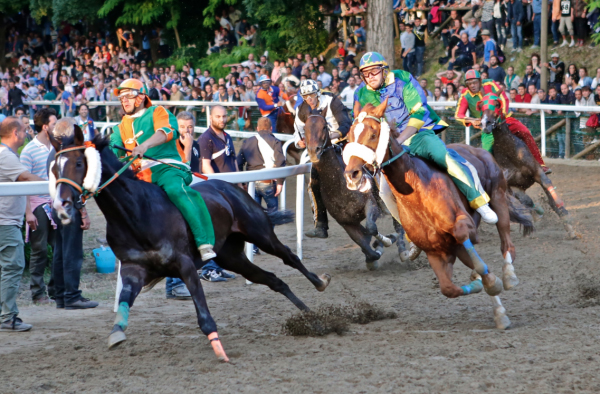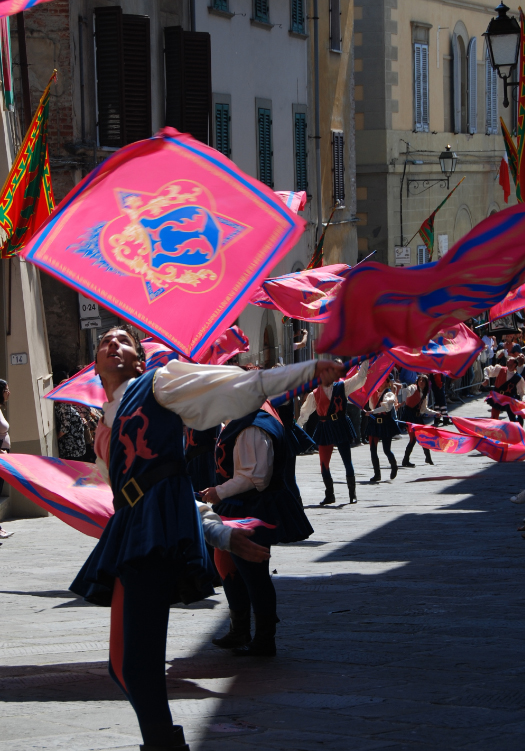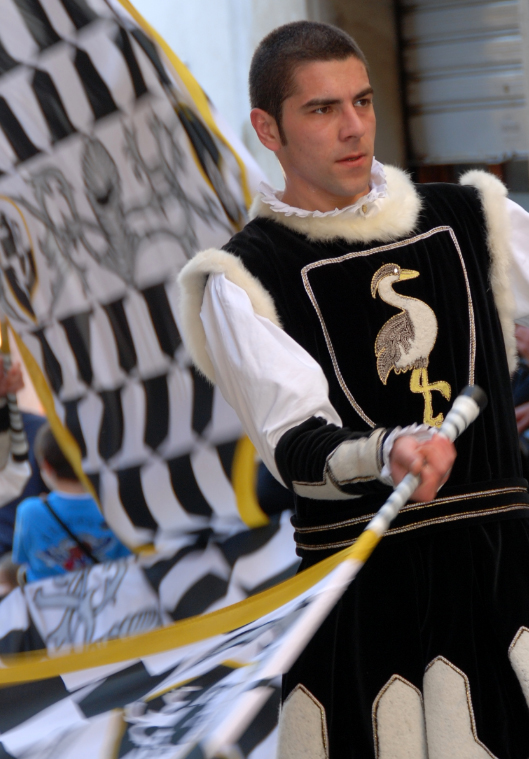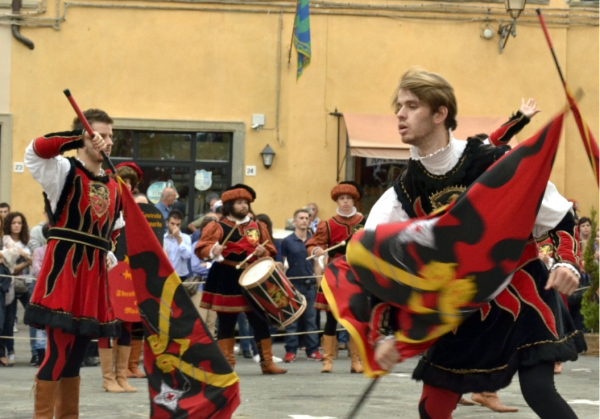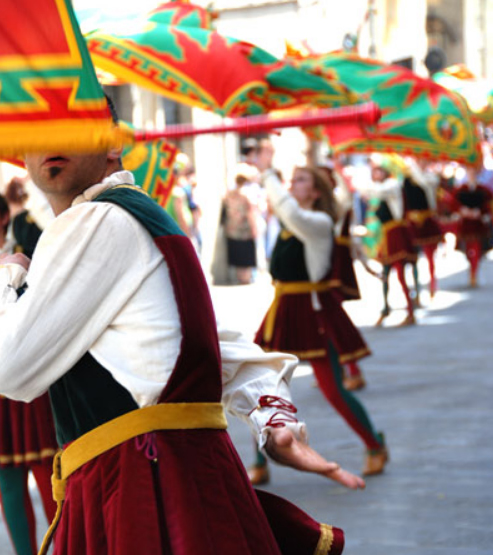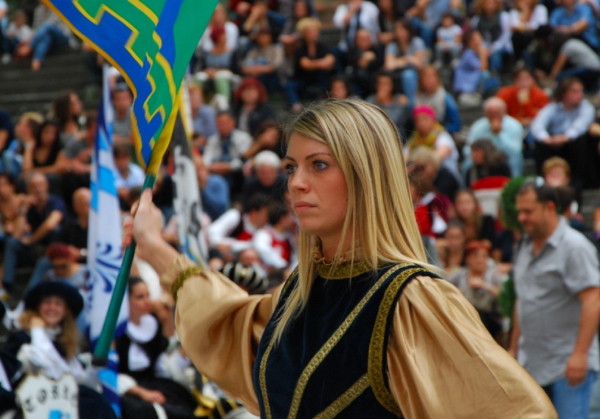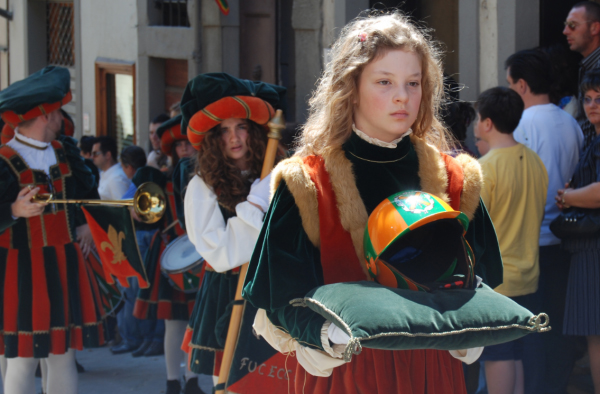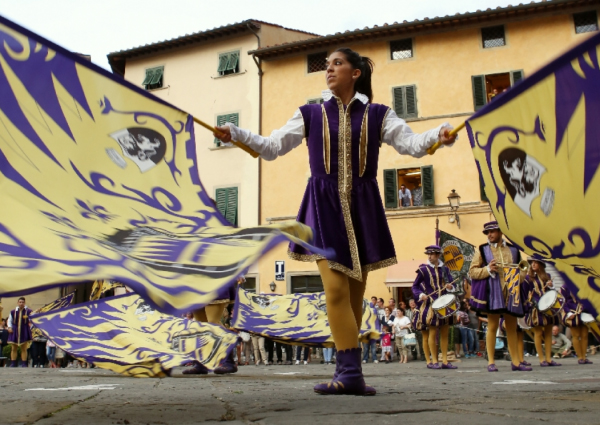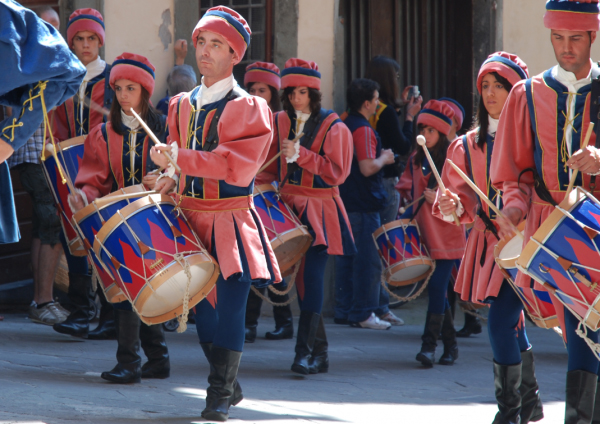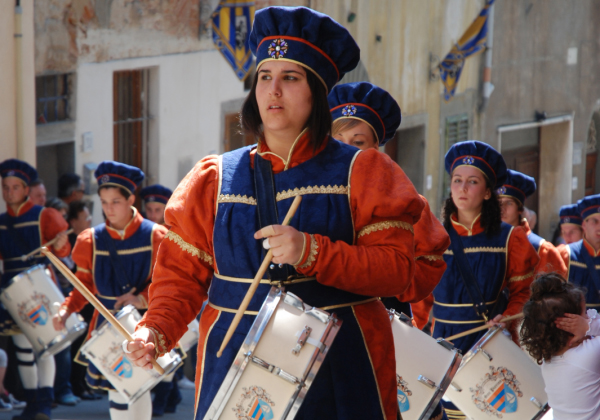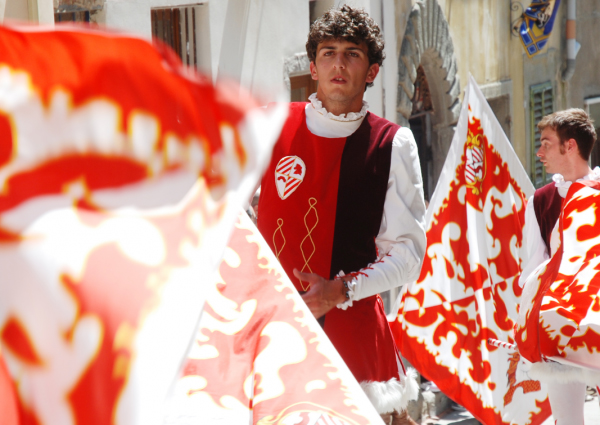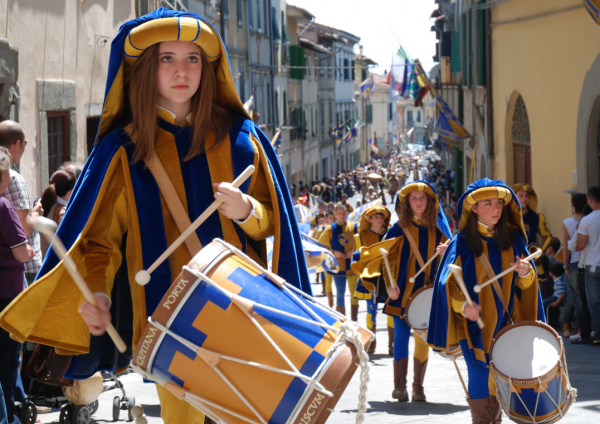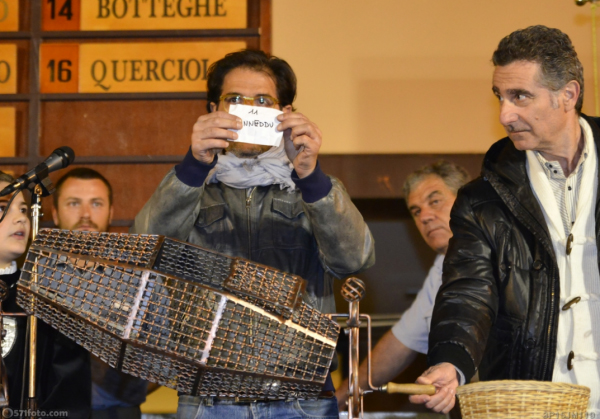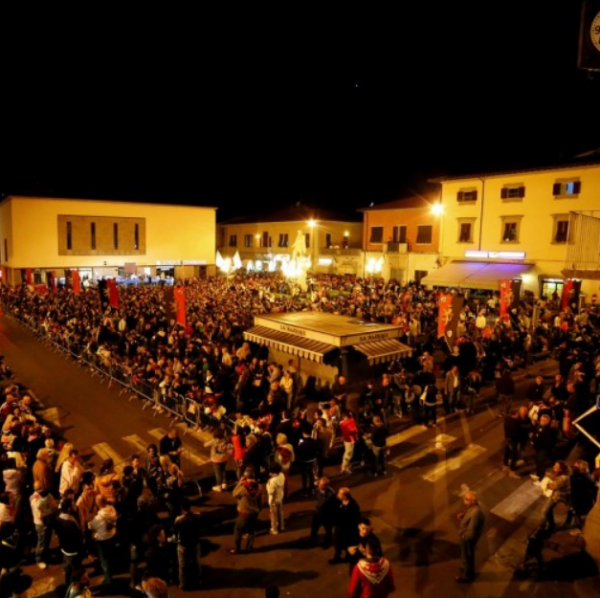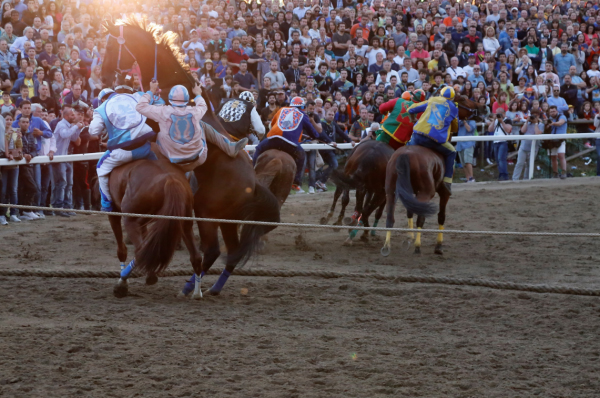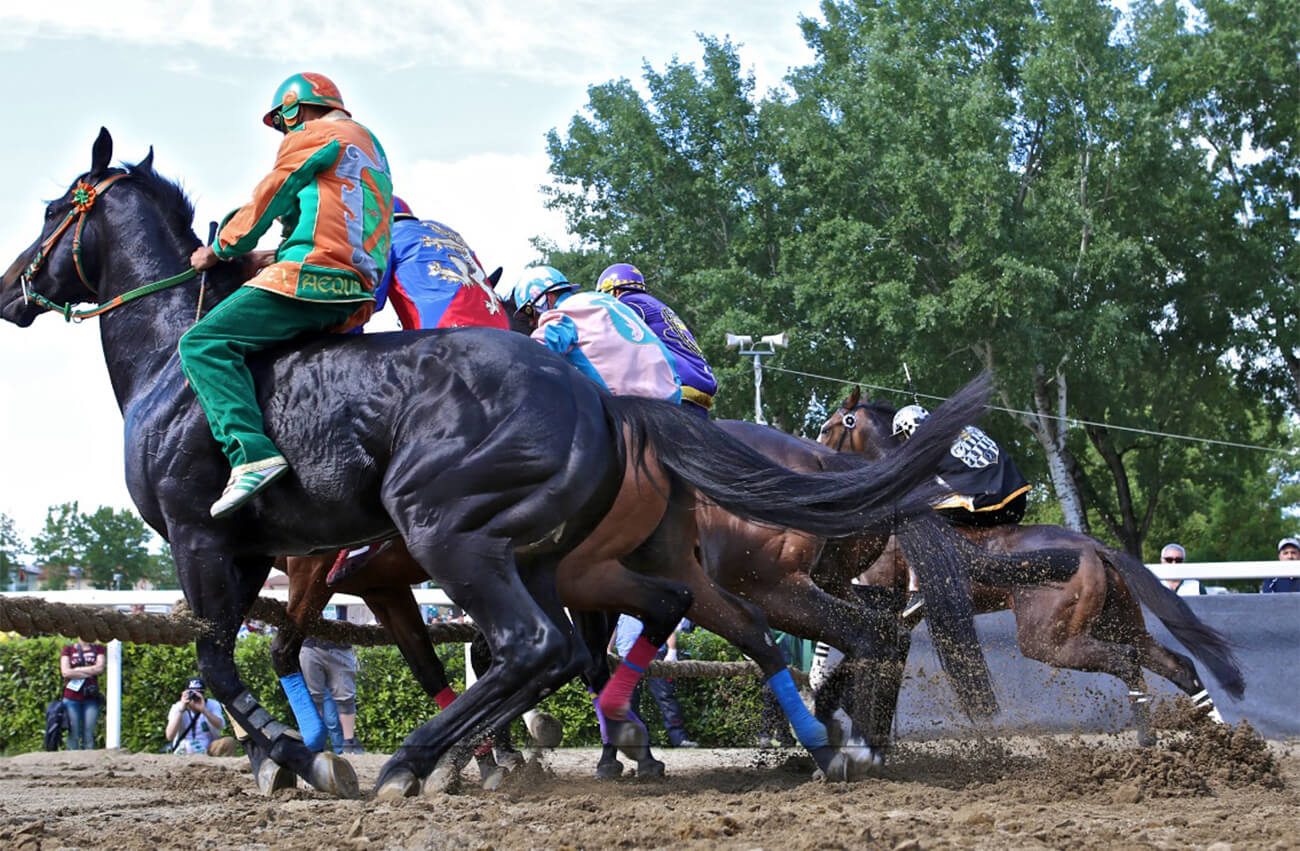
Il Palio
An ancient contest of medieval origins, a rebirth that, from 1981 onwards, has seen a continuous growth of enthusiasm and interest: the Palio delle Contrade today plays a primary role in the daily life of citizens and in the historical events of Tuscany. The undisputed protagonists of the event are the 12 Contrade: Borgonovo, Botteghe, Cappiano, Ferruzza, Massarella, Porta Bernarda, Porta Raimonda, Querciola, Samo, Sant’Andrea, San Pierino and Torre.
The great race of the penultimate Sunday in May is the culmination of an entire week of events, including the presentation of the rag and the historical parade, with flag-wavers and more than a thousand extras, and is preceded by other collateral initiatives during the year. Once the competition is over, a new cycle of preparation and waiting begins: for every Fucecchiese the Palio is an everyday story made of passion.
All events are organized and promoted by the Municipality of Fucecchio and the Palio delle Contrade Association. Visit the official website of the event:
www.paliodifucecchio.it
Palio delle Contrade
THE ORIGINS OF THE PALIO
At the beginning of the Palio delle Contrade, as it is said, there is an ancient contest, called the Gioco or Palio della Lancia, which took place many centuries ago in the city of Fucecchio. According to some, the purpose of the game was to insert the spear, in fact, into the iron rings walled into the facades of ancient buildings, usually used to tie horses; according to others, the carousel envisaged to thread the spear three times into a ring attached to the end of a cord hanging from a big bag full of water.
Over time, real horse races were organized in the streets, within both religious and civil festivals, an ancient custom of almost all the towns of Tuscany. “Individuals won”, Riccardo Cardellicchio says, “but from time to time the signs of districts came out. Sporadic initiatives in the eighteenth and nineteenth centuries.”
Still in 1855, shortly before the spread of cholera in the city, the annual Palio della Lancia was held, but it was not organized for the next eight years, due to the historical and political contingencies of the Italian unification. The last dispute of this kind, according to the documents that are still found today in the local historical archive, was held on June 14, 1863; it was followed by the final burial of the Giostra.
In 1980 it was the Fratres blood donors group, with its president Tommaso Cardini, who revived the dispute by organizing a pony race to promote blood donation. The decision to organize a real Palio delle Contrade, with horses mounted by jockeys, was taken the following year. After an initial presence of sixteen districts, the number definitively dropped to the current twelve, and in 1995 the Palio, which has now grown a lot compared to the first modern edition, passed into the hands of the municipal administration.
Writes the journalist and writer Riccardo Cardellicchio about the rebirth of the Palio:
“It was a start – in 1981 – outside the country. An attempt that could have failed. But the answer was enthusiastic and thrilling. Fucecchio and its territory were covered with flags and colors. There was talk of districts. We discovered Borgonovo, Ferruzza, Sant’Andrea, Porta Bernarda, Porta Raimonda, Samo, and the hamlets further enhanced their “diversity”, dusting off their history of castles along the Way of God, the via Romea (and Francigena, later) and marshy ports. The districts opened small offices, where people gathered to talk about the historical cortege, the horse and the jockey to be hired, or even simply to be together, to make a few jokes with a laugh. To talk about more and less. Almost new vigils, no longer “in the song of the fire”, but in cramped rooms, refurbished a little, or parts of old factories.
Not everyone immediately understood the importance of the Palio. But, over time, the corners were rounded off. It was understood that Fucecchio loved, and loves, the Palio, because he did it, and he does, feel alive, because it gave, and gives, the opportunity to people to be together, without division. To be a protagonist”.
Sources:
Riccardo Cardellicchio, Breviary for an event (1996)
Mario Catastini, History of Fucecchio, facts, characters and events
THE RACE AND OTHER EVENTS OF THE PALIESCA WEEK
The horse race takes place on the afternoon of the penultimate Sunday in May in the green area of the Buca del Palio, where a sand ring track has been created. Based on the total number of Contradas that are currently in the Association, the race is divided into three races: two heats, consisting of six horses each, and the final, in which eight horses compete, with the top four in the previous heats. For all races, both the position of the horses on the rope and the run-up horse are drawn.
The historical parade, with its more than a thousand figures in magnificent costumes, takes place on the morning of the Palio and runs through the main streets of the town. Each district proposes the re-enactment of a historical period within a broader theme, namely the evolution of city customs from 1200 to 1800. The historical procession is opened by the Banner of the Municipality of Fucecchio, which precedes the banner of the Palio Association delle Contrade and the Contrada winner of the last edition. Behind her all the others parade, according to the order drawn publicly during the presentation evening of the Palio. The parade ends with the Cencio, or the painted squad that will be disputed in the afternoon at the race.
In the days preceding the race, in addition to the historical parade, other initiatives are planned. On Tuesday of the week of the Palio, the veterinary visit of the horses entered in the competition takes place and, in the evening, the ceremony for the presentation of the Cencio. The next day, however, it is time for Tratta: goddess blindfolded is the host in the draw and in the consequent assignment of the horses to the Contrade. Compulsory tests are scheduled on Thursday and Friday, while the jockeys’ presentation and registration ceremony takes place on Saturday.
Watch the videos on the official Youtube channel of Palio di Fucecchio.
THE WEEK OF THE PALIO
The collateral initiatives
Day that passes, there is an increasing air of palio.
(Riccardo Cardellicchio)
We could thus summarize that electric atmosphere, of expectation and hope, that the city of Fucecchio not only collects and enhances during the Paliesca week, but also distills in other collateral initiatives dedicated to children, to competition and horse enthusiasts and to those who loves folkloristic re-enactments.
SPRING RACES
A real anticipation of the Palio, which precedes by about a month, the Spring Races allow the districts to better evaluate the animals that will then be able to participate in the May event. It is an appointment to mark on the calendar both for the contradaioli and for horse and equestrian racing enthusiasts that are disputed between city districts.
THE GREAT GALÀ
An unmissable opportunity for those who love ancient traditions and folklore, the Gran Galà degli Sbandieratori e dei Musici has been held in Fucecchio since 2011. The protagonists of this festival of music and colors are the flag-wavers of the 12 districts, who perform accompanied by drums and trumpets. of their companions.
Until last year, the Grand Gala took place in October and sanctioned the ideal end of the Paliesca season; from 2018, however, the event takes place at the end of April, as if to introduce the competition that will be held in a month’s time. The development has also changed slightly: the maximum duration of the performances is set at 10 minutes and each district, within its exhibition, presents a game with the “great team”, a joint show between trumpets, musicians and flag-wavers. It all ends with a final game involving the 12 districts. Finally, all the participants parade through the streets of the center accompanied by the sound of the music group of the Contrada Sant’Andrea.
THE GAME OF THE PALIO
Exactly one week after the main race, the Game of the Palio is held, an initiative that involves the children of the Fucecchio schools and groups of the youngest from each district. The event was opened by the parade of the small contradaioli, followed in the afternoon by medieval games for children, for a whole day dedicated to being together and cheerfulness. As part of this initiative, the Contrade market is also held, during which each district distributes its gadgets and its own recognition colors to enhance the deep bond that unites citizens and their own district.
THREE FUCECCHIESI FANTINI IN PIAZZA DEL CAMPO
“I am looking for a Franciscan friar, news about him, who lived at the time of Savonarola, and I come across – surprisingly – three jockeys from Fucecchies. Figurines that emerge from the nineteenth century, which from Fucecchio managed to land in Piazza del Campo, in Siena, to run the Palio.
I meet Antonio Guaschi first (not Guasqui). Born in Fucecchio in the (presumed) year 1827. At the age of twenty, exactly on August 16, 1847, he made his debut in Siena in the Palio dell’Assunta, with the battle name Folaghino, which recalls marshy areas. An extraordinary debut. He wins with the horse of the Nicchio district. He stands still in 1848, like everyone else. Career skips due to the First War of Independence. It is the year of Curtatone and Montanara. in July 1849, there are three palios: July, August and October. The extraordinary one – in October – is dedicated to the inauguration of the Empoli-Siena railway line. Folaghino is not successful in any of the three. But he wins, in 1850, that of 2 July for the Chiocciola and is repeated, on 16 August, again for the Chiocciola. The following year he is again first in the Palio of 17 August for the Wave. Then he disappears with a not bad palmares. Four palios won out of seven courses. The reason for the disappearance is unknown. There is no news from Siena either. And the imagination goes free. An injury, an illness, but also different choices. Certainly not the age.
The participation in the Palio of Siena of the second jockey I meet is longer: Gonga. In the century Pietro Montanelli, born in Fucecchio in all probability in 1834. Eleven Corsican palios and no victory. Debut (at an advanced age) in the Palio of July 1874 with the Chiocciola district. In August, he defends the colors of the Eagle. In July 1875 he is with the Panther. A year later, again in July, with the Dragon, and, in August, with the Civetta. In August 1877 he was with the Caterpillar. The following year, in August, with the Eagle. In July and August 1879 he is with the Tartufa. The following year, in July, with the Eagle. It closes in July 1881 with the Bruco. After seven years. A presence in Piazza del Campo without the satisfaction of victory.
The third jockey, born in 1838, makes a fleeting appearance at the Palio dell’Assunta in 1858 with the colors of the hedgehog. Name Santi Soldaini, called Volpe. Who knows what makes him move away from Piazza del Campo.
These three jockeys refer us to Fucecchio which in the nineteenth century organized palios to run in via Dante for important religious holidays. And who raised jockeys who could then have the opportunity to assert themselves elsewhere, to get as far as Siena. Fucecchio is also the land of cavallai and the annual cattle fair, where the horse was king. Three names – Folaghino, Gonga, Volpe – that can find a place in the imagination of those (and they are the most) who love the Palio, also a piece of our history.”
Taken from: Riccardo Cardellicchio, People and Places, Il Tirreno



